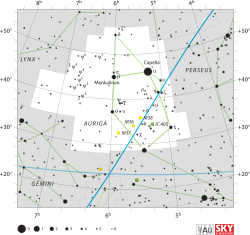Pi Aurigae
| Observation data Epoch J2000 Equinox J2000 | |
|---|---|
| Constellation | Auriga |
| Right ascension | 05h 59m 56.0994s[1] |
| Declination | +45° 56′ 12.248″[1] |
| Apparent magnitude (V) | 4.25[2] |
| Characteristics | |
| Evolutionary stage | asymptotic giant branch[3] |
| Spectral type | M3 II[4] |
| U−B color index | +1.83[2] |
| B−V color index | +1.72[2] |
| Variable type | LC[5] |
| Astrometry | |
| Radial velocity (Rv) | 0.71 ± 0.76[6] km/s |
| Proper motion (μ) | RA: −2.42[1] mas/yr Dec.: −7.32[1] mas/yr |
| Parallax (π) | 3.88 ± 0.85 mas[1] |
| Distance | approx. 800 ly (approx. 260 pc) |
| Absolute magnitude (MV) | −2.46[7] |
| Details | |
| Radius | 265[8] R☉ |
| Luminosity | 6,493[9] L☉ |
| Surface gravity (log g) | 0.55±0.10[10] cgs |
| Temperature | 3,388±6[10] K |
| Metallicity [Fe/H] | 0.03±0.04[10] dex |
| Other designations | |
| Database references | |
| SIMBAD | data |
Pi Aurigae, Latinized from π Aurigae, is the Bayer designation for a single,[12] red-hued star in the northern constellation of Auriga. Located about one degree north of the 2nd magnitude star Beta Aurigae,[13] Pi Aurigae is visible to the naked eye with an apparent visual magnitude of 4.25[2] Based upon parallax measurements, it is approximately 800 light-years (250 parsecs) away from Earth.[1] At that distance, the brightness of the star is diminished by 0.54 in magnitude from extinction caused by interstellar gas and dust.[6]
Pi Aurigae is an evolved bright giant star with a stellar classification of M3 II.[4] The measured angular diameter of this star, after correction for limb darkening, is 9.56 ± 0.10 mas.[14] At the estimated distance of Pi Aurigae,[1] this yields a physical size of about 265 times the radius of the Sun.[8] On average, the star is radiating 6,493[9] times the Sun's luminosity from its enlarged photosphere at an effective temperature of 3,388 K.[10] It is classified as a slow irregular variable of type LC and its brightness varies from magnitude +4.24 to +4.34.[5]
References
- ^ a b c d e f g van Leeuwen, Floor (November 2007), "Validation of the new Hipparcos reduction", Astronomy and Astrophysics, 474 (2): 653–664, arXiv:0708.1752v1, Bibcode:2007A&A...474..653V, doi:10.1051/0004-6361:20078357. Note: see VizieR catalogue I/311.
- ^ a b c d Johnson, H. L.; et al. (1966), "UBVRIJKL photometry of the bright stars", Communications of the Lunar and Planetary Laboratory, 4 (99), Bibcode:1966CoLPL...4...99J.
- ^ Eggen, Olin J. (July 1992), "Asymptotic giant branch stars near the sun", Astronomical Journal, 104 (1): 275–313, Bibcode:1992AJ....104..275E, doi:10.1086/116239.
- ^ a b Morgan, W. W.; Keenan, P. C. (1973), "Spectral Classification", Annual Review of Astronomy and Astrophysics, 11: 29, Bibcode:1973ARA&A..11...29M, doi:10.1146/annurev.aa.11.090173.000333.
- ^ a b Ruban, E. V.; et al. (September 2006), "Spectrophotometric observations of variable stars", Astronomy Letters, 32 (9): 604–607, Bibcode:2006AstL...32..604R, doi:10.1134/S1063773706090052.
- ^ a b Famaey, B.; et al. (January 2005), "Local kinematics of K and M giants from CORAVEL/Hipparcos/Tycho-2 data. Revisiting the concept of superclusters", Astronomy and Astrophysics, 430 (1): 165–186, arXiv:astro-ph/0409579, Bibcode:2005A&A...430..165F, doi:10.1051/0004-6361:20041272.
- ^ Anderson, E.; Francis, Ch. (2012), "XHIP: An extended hipparcos compilation", Astronomy Letters, 38 (5): 331, arXiv:1108.4971, Bibcode:2012AstL...38..331A, doi:10.1134/S1063773712050015.
- ^ a b Lang, Kenneth R. (2006), Astrophysical formulae, Astronomy and astrophysics library, vol. 1 (3rd ed.), Birkhäuser, ISBN 3-540-29692-1. The radius (R*) is given by:
- ^ a b McDonald, I.; et al. (2012), "Fundamental parameters and infrared excesses of Hipparcos stars", Monthly Notices of the Royal Astronomical Society, 427: 343, arXiv:1208.2037, Bibcode:2012MNRAS.427..343M, doi:10.1111/j.1365-2966.2012.21873.x.
- ^ a b c d Wu, Yue; et al. (January 2011), "Coudé-feed stellar spectral library - atmospheric parameters", Astronomy and Astrophysics, 525: A71, arXiv:1009.1491, Bibcode:2011A&A...525A..71W, doi:10.1051/0004-6361/201015014.
- ^ "pi. Aur -- Pulsating variable Star". SIMBAD. Centre de données astronomiques de Strasbourg. Retrieved 2012-08-20.
{{cite web}}: CS1 maint: postscript (link) - ^ Eggleton, P. P.; Tokovinin, A. A. (September 2008), "A catalogue of multiplicity among bright stellar systems", Monthly Notices of the Royal Astronomical Society, 389 (2): 869–879, arXiv:0806.2878, Bibcode:2008MNRAS.389..869E, doi:10.1111/j.1365-2966.2008.13596.x.
- ^ O'Meara, Stephen James (2007), Steve O'Meara's Herschel 400 Observing Guide, Cambridge University Press, p. 23, ISBN 0521858933.
- ^ Richichi, A.; Percheron, I.; Khristoforova, M. (February 2005), "CHARM2: An updated Catalog of High Angular Resolution Measurements", Astronomy and Astrophysics, 431: 773–777, Bibcode:2005A&A...431..773R, doi:10.1051/0004-6361:20042039.


